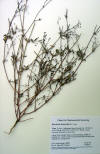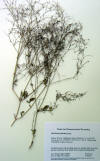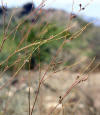|
Boerhavia intermedia |
Boerhavia spicata |
|
Boerhavia wrightii |
|
|
Ahmed-Belkacem A., S. Macalou, F. Borrelli, R. Capasso, E. Fattorusso, O. Taglialatela-Scafati and A. Di Pietro. 2007. Nonprenylated rotenoids, a new class of potent breast cancer resistance protein inhibitors. J. Med. Chem. 50(8): 19331938. Two rotenoids isolated from Boerhaavia diffusa (Nyctaginaceae), boeravinones G (1) and H (2), have been found to potently inhibit the drug efflux activity of breast cancer resistance protein (BCRP/ABCG2), a multidrug transporter responsible for cancer cell resistance to chemotherapy. The isolation of nine additional rotenoid derivatives (3-11), including the new boeravinones I (10) and J (11), from the extract of B. diffusa roots allowed us to establish structure-activity relationships toward inhibition of BCRP-mediated drug transport activity. The results show the positive roles of a methoxy group at position 6 of ring B and the absence of a substituent at position 10, and the requirement for a 6a/12a double bond between rings B and C. In contrast, both contraction of ring B, to give a coumaronochromone (11), and tetrasubstitution of ring D appeared to be detrimental for the inhibitory potency. The present study provides the first data on the BCRP-inhibiting activity of rotenoid derivatives, indicating boeravinones as a new class of interesting BCRP inhibitors.
Borrelli F, V.
Ascione, R. Capasso, A. A. Izzo, E. Fattorusso and O. Taglialatela-Scafati.
2006. Spasmolytic effects of nonprenylated rotenoid constituents of
Boerhaavia diffusa roots. J. Nat. Prod. 69(6): 903906. Boerhaavia
diffusa is an Ayurvedic remedy used traditionally for the treatment of
a number of diseases, including those affecting the gastrointestinal
tract. In the current investigation, a methanol extract obtained from
roots of B. diffusa exhibited a significant spasmolytic activity in the
guinea pig ileum, probably through a direct effect on the smooth muscle. A
detailed phytochemical analysis of this methanol extract led to the
isolation of one new (12) and six known (6-11) rotenoid derivatives. The
structure of the new compound was determined through interpretation of its
MS and NMR data. All the isolated rotenoids were evaluated for their
effect on intestinal motility in vitro, and the results obtained showed
unambiguously that they are active spasmolytic constituents. Preliminary
structure-activity relationships for this class of compounds are suggested. |
|





